Around The Year with The von Trapp Family – A Review

Several years ago, when my children were still quite young and I was eager to find any connection I could to the rich treasures I knew to be woven into the liturgical year, a dear friend of mine shared her knowledge of a resource which illuminated so much of my path, Around The Year with the von Trapp Family by Maria August Trapp. Maria!!! Whom I fell in love with in The Sound of Music, and who, it turns out, wrote a beautiful book detailing the riches of living their treasured Catholic faith.
As you know if you have memorized every single line of “The Sound of Music” (and I’m not saying that I have or anything), the von Trapp family fled Nazi occupied Austria after refusing to sing for Hitler’s birthday party, left their beloved homeland, and eventually settled in America (Vermont specifically). While the movie may not represent with complete historical accuracy the family that we fell in love with on-screen, it was based on some of the true happenings within the family. You can read the true story of the von Trapp family in The Story of the Trapp Family Singers – the Story Which Inspired The Sound of Music and in Memories Before and After The Sound of Music, An Autobiography by Agathe von Trapp. Both are excellent books and I highly recommend them for your Mother’s Morning Basket reading as well as for your high school readers studying the 20th century!
My joy in finding out about Maria’s book from my friend was short-lived when I learned that not only was the book out of print, but it was also hard to find.
I began my search. Saved ebay searches. Abebooks alerts. All my old used book hunting grounds were combed. And then finally, one day, I found it and bought it. An original 1955 edition!
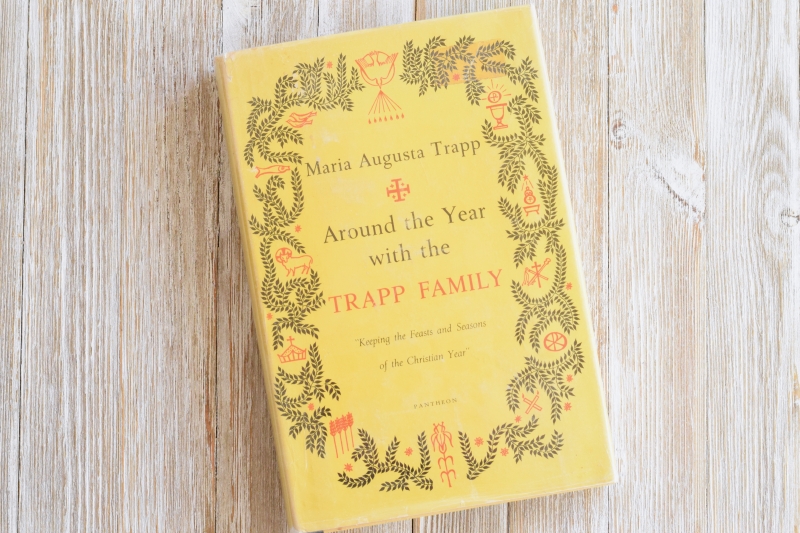
It has been a treasured anchor of my own understanding of the liturgical year, but it also taught me much about how a family could begin to weave the liturgical year into the rhythm of ordinary days.
In my search for Maria’s book, I would soon make another connection. I discovered that my other favorite liturgical year author, Father Father Weiser, was a long-time friend of the von Trapp’s, and influenced the family heavily, both before the war, and during their time in America. Father Weiser wrote an entire series of books and my introduction started with his book, Handbook of Christian Feasts and Customs, which is a reference that sprung from and expanded on his first three volumes: The Christmas Book, The Easter Book and The Holy Day Book. Father Weiser’s book illuminated my understanding of the history of the feasts, customs and holy days within the Christian liturgical year. Father Weiser advised the von Trapp family, provided the Sacraments, and enriched their own understanding of the beautiful liturgical year within the Church. His voice is woven in and out of the pages of Around The Year!
And so, with eagerness I read and re-read those pages, and each season I open it anew. And each year I’m grateful again for its riches.
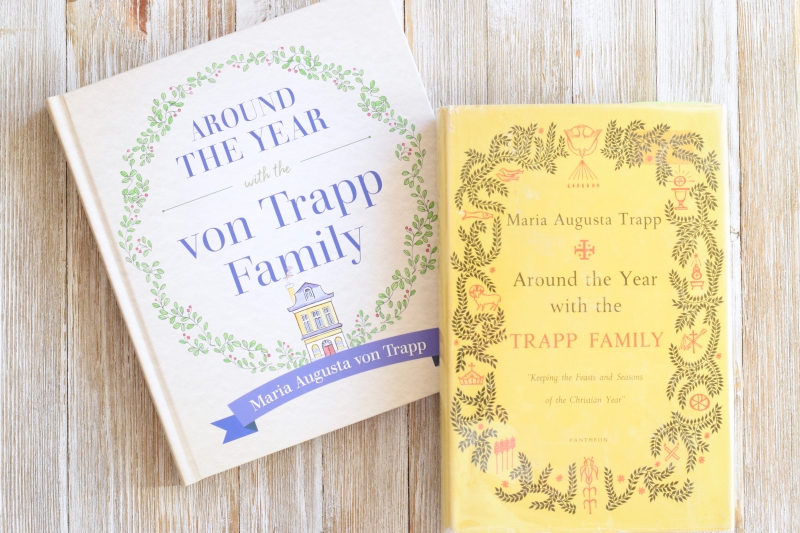
Sophia Institute Press has recently reprinted Around The Year with the von Trapp Family – for all of us! And they very graciously provided me a copy to review for you here – thank you, Sophia! No longer will you have to search and hunt – it is readily available. Sophia Institute Press is offering my readers a discount of 25% off the price of the book if you shop this link and enter the code: radio25.
Today, I get to share some images and some of the reasons this book still resonates with me and finds a treasured home on my family shelves, and I hope to invite you to consider this book for your own liturgical year shelves.
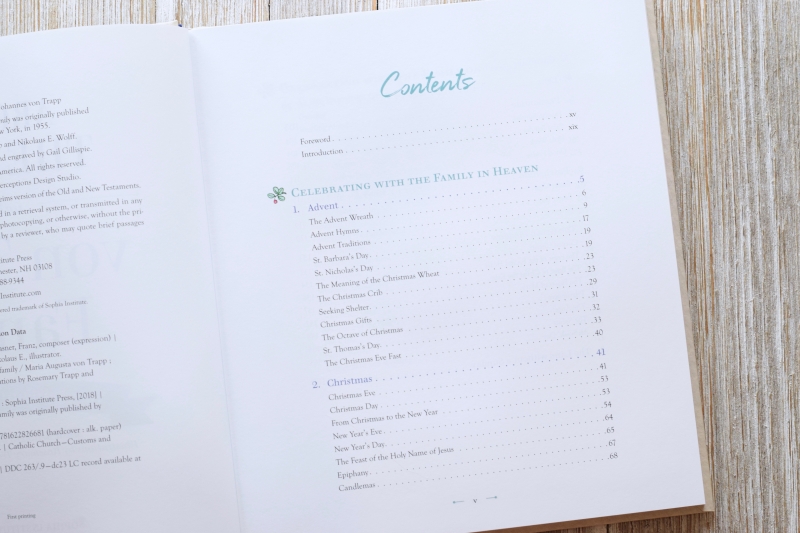
The contents of the book are shown above and below and I did that to show you just how comprehensive this book is – it encompasses the entire liturgical year! Every major season is covered, and so are those times that Maria refers to as, The Green Meadow, which is the second half of the Church Year and refers to the green vestments worn on the Sundays after Pentecost.
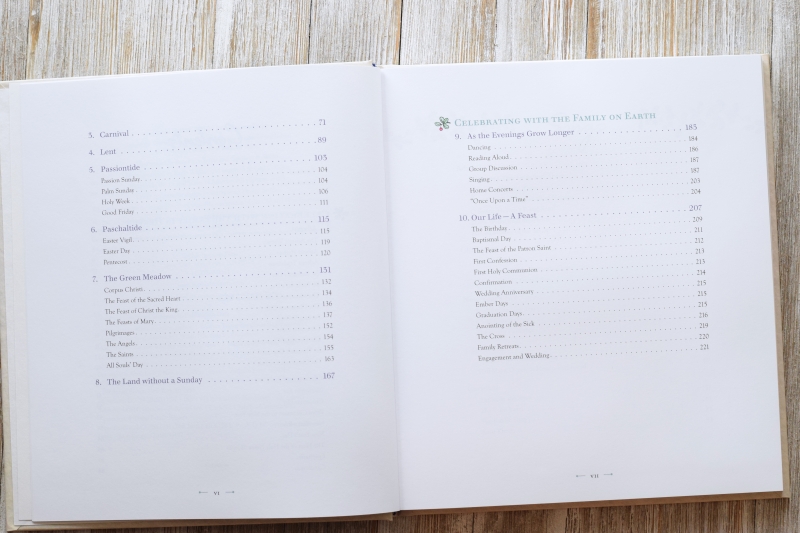
Holy Mother Church wants, through the liturgical year, to teach Her children to make time for celebrating. And this book holds your hand.
In his encyclical, Quas Primas (1925), Pope Pius XI sets in place for us the great Feast of Christ the King, acknowledging the need the world has of His Kingship. And then Pope Pius XI says something very important – he underlines for us the great value in living the liturgical year. It is a quote that has animated me for years and serves all families well.
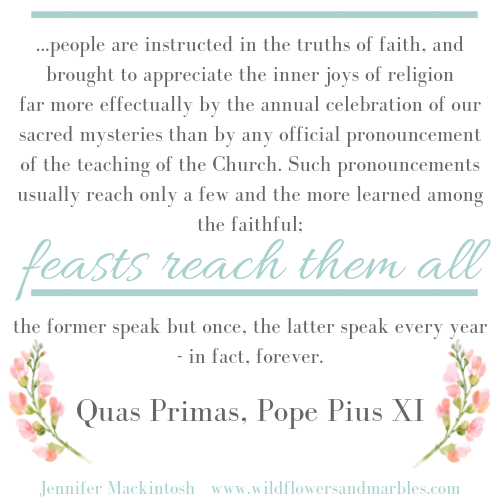
It is this animating thought that keeps our family anchored to the liturgical year; to everything there is a season. And it is this idea, universal and timeless, that Maria unfolds for us in her book, Around The Year.
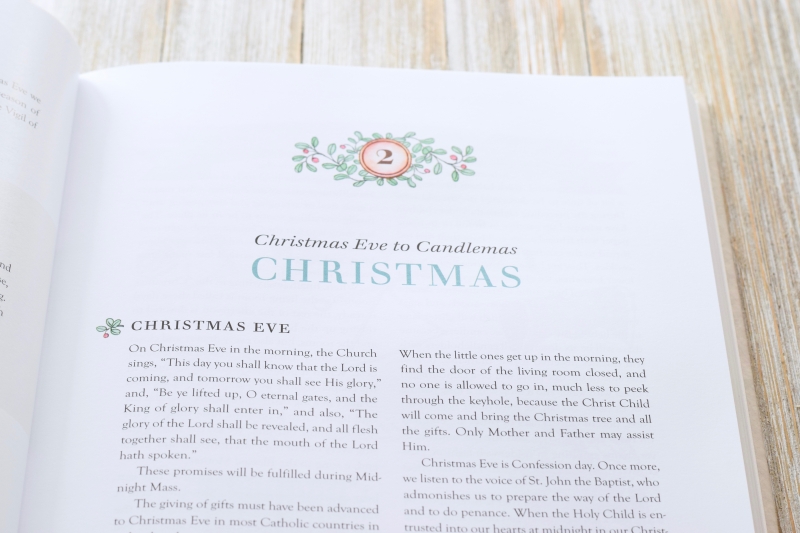
Knowing that this entire book is about celebrating, and living the liturgical year, I’ll start by sharing with you an outline of the book’s layout, which follows the original 1955 edition exactly.
The book is divided into two sections: Celebrating with the family in Heaven & Celebrating with the family on Earth.
CELEBRATING WITH THE FAMILY IN HEAVEN
Let’s tackle the first section, Celebrating With The Family in Heaven. Each chapter contains a lovely description of the von Trapp family traditions in celebrating the season or feast, but there are also recipes and beautiful, seasonally appropriate hymns throughout. Much has been done to trample the rich music in the Church. Let this book show you how theologically rich our seasonal hymns were, and can be again!
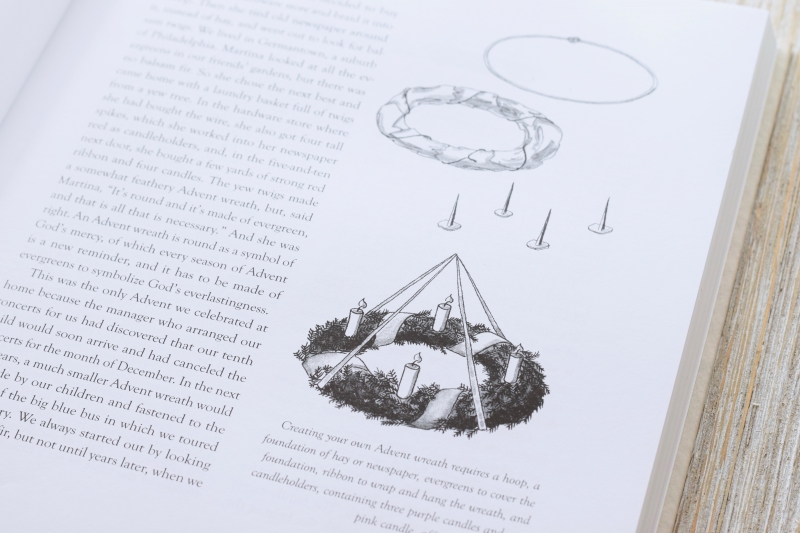
- Advent – Advent is probably one of my favorite chapters – just because of the many rich traditions I uncovered in reading it. So much was lost in the name of updating. As a young mother, I felt the loss keenly. There was no foothold; no foundation to build from. I felt lost until I found the liturgical year and the treasures that families used to express in living it out. This book was one of those anchor points for me.
- Christmas – this chapter will help you live this season, which you may know lasts through Epiphany, but may technically be celebrated through Candlemas. Speaking of Candlemas, there is a beautiful explanation of Candlemas, which wraps up the chapter on Christmas. The law of Moses required every Jewish mother, after giving birth to a male child, to refrain from public worship for forty days, at the end of which she had to present a sacrifice, thus purifying herself. The Gospel shares how Mary fulfilled this command of the law, and from the earliest days of the Church it was observed as a feast, called simply “the fortieth day after Epiphany” (Handbook of Christian Feasts and Customs, Weiser). It was later (around 701) that candles and a procession emphasizing light was instituted. Some explain the insertion of the light into the Feast of the Purification as Maria does in Around The Year, explaining that in Ancient times February 1 was a day which women walked around with torches and lights in honor of the goddess Ceres. The Church continued the custom and baptized the practice, attaching it to the Feast of the Purification of Mary and the Presentation of her little Son in the temple which takes place on February 2. We celebrate the Feast of the Purification of Mary, and conclude with a special blessing for candles, and the Church instructs us on the very deep and meaningful symbolism of the candle and light in the liturgy and in the rhythm of our days. Candlemas. So many layers of richness to understand and appreciate. And yet the richness unfolds through the Holy Sacrifice of the Mass, the liturgical year, and the simple candle. Feasts reach them all.
- Carnival – takes us through the season from January 6 (Epiphany) through Ash Wednesday.
- Lent – as you can imagine this chapter covers all of the important aspects of the penitential season. If you’ve ever wondered where the popular notion (you can find ideas and images on blogs and all over Pinterest) for “burying the Alleluia” comes from, you may be surprised to learn it is not modern at all. It is in fact, quite old, originating in the Middle Ages. Maria explains in her book and offers some additional insight. And, perhaps as you read this section, you will be like me when I first read Around The Year, many years ago, and find yourself quite surprised that at one time, the Church’s calendar gave us the season of Pre-Lent: two and a half weeks covering Septuagesima Sunday, Sexagesima Sunday, and Quinquagesima Sunday (and the Mon, Tues and Wednesday following), which serve as a time of “transition for the soul, which must pass from Christmas joys…to the stern penance of the sacred forty days of Lent.” (Around the Year, p. 89) While the Pre-Lenten days are no longer observed on the Novus Ordo calendar (they are retained if you follow the 1962 calendar of the Extraordinary Form), there is no reason a family might not consider the value in these days and incorporate them into the family rhythm as a common sense way of transitioning.
- Passiontide – “If Septuagesima seasons acts as a remote preparation for Easter, and Lent the proximate one, the two weeks of Passiontide are the immediate preparation.” (Around The Year, p. 103) I loved reading the von Trapp family’s preparations through the Holy Triduum. While we must quiet the interior to fully prepare, there are a fair share of Martha moments of preparation. Rightly directed, these Martha moments can be aids in our preparation for the approaching Feast. Maria’s example inspired me to set my own family practice in place: for years, I have set up our Lenten season as one of detachment (read: going through every closet, attic, toy bin, kitchen drawer – and decluttering and donating much!), and Passiontide is reserved for spring cleaning.
- Paschaltide
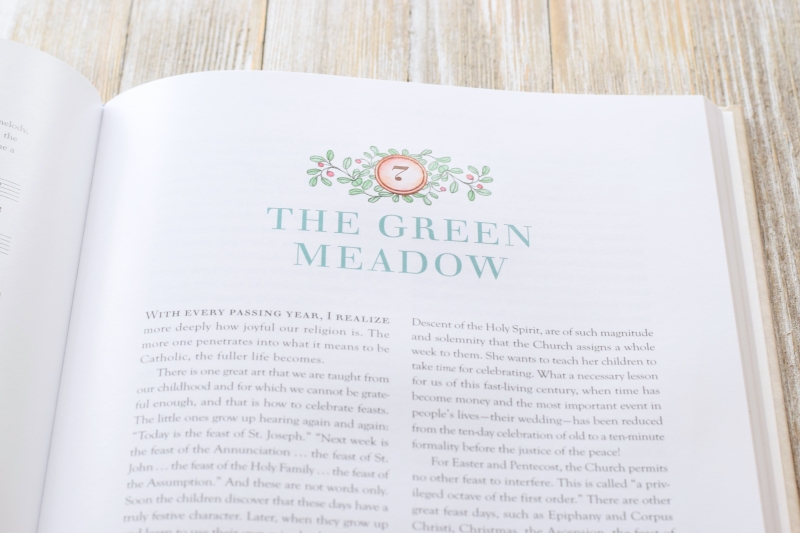
- The Green Meadow – is one of my favorite chapters! We often have guidelines for the big seasons, but there is much richness to be found in the green meadow, the time after Pentecost. It was in this chapter I began to truly understand the idea of the rankings of the Feasts within the Church – first and of primary importance come the Feasts of Our Lord, then secondly Feasts of the Blessed Virgin Mary, then the Holy Angels, followed by the Saints, and then the dedication of churches, etc. But Maria reminds us, “even a simple feast day is a feast day.” And here we are introduced to feria days, and how very important they are in our living the liturgical year as well. A feria day is is simply a day we do not celebrate a feast. But why would Mother Church instruct us not to celebrate by designating on the Church Calendar a day of feria? Because in Her wisdom, She instructs us in these days, too. An example would be the string of feria days in Lent. The Church assigns particular Masses for every feria day in Lent, which keep us in check as we focus on penance during these weeks. And this penance, all this non-celebrating, it prepares us. It is an absence, and like all absences, it makes the joyful Alleluia on Easter morning all the sweeter. There is great wisdom in the Church’s year, and Maria helps us unpack it and understand it in Around The Year.
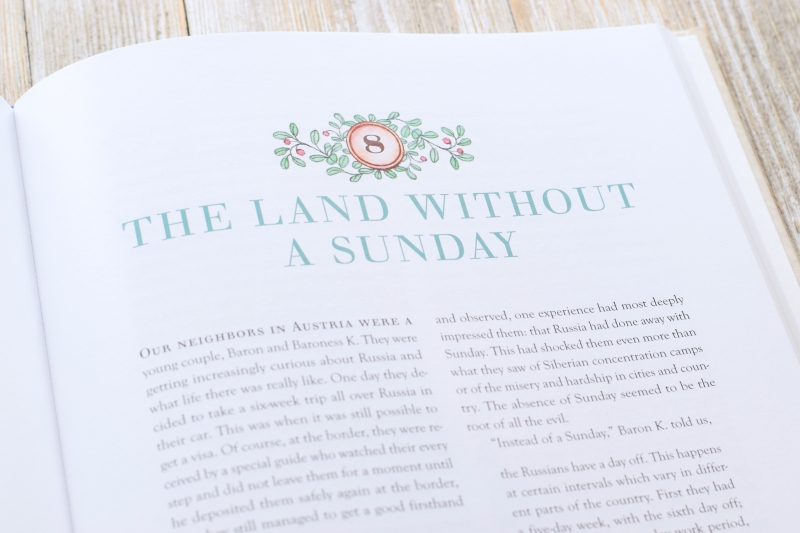
- The Land Without a Sunday – is a beautiful essay that is part historical lesson and part cautionary tale. It will transform how you think of Sunday, and perhaps animate a change inspired by Maria and Pope Pius XII who reminds us: “The results of the struggle between belief and unbelief will depend to a great extent on the use that each of the opposing fronts will make of Sunday.“
CELEBRATING WITH THE FAMILY ON EARTH
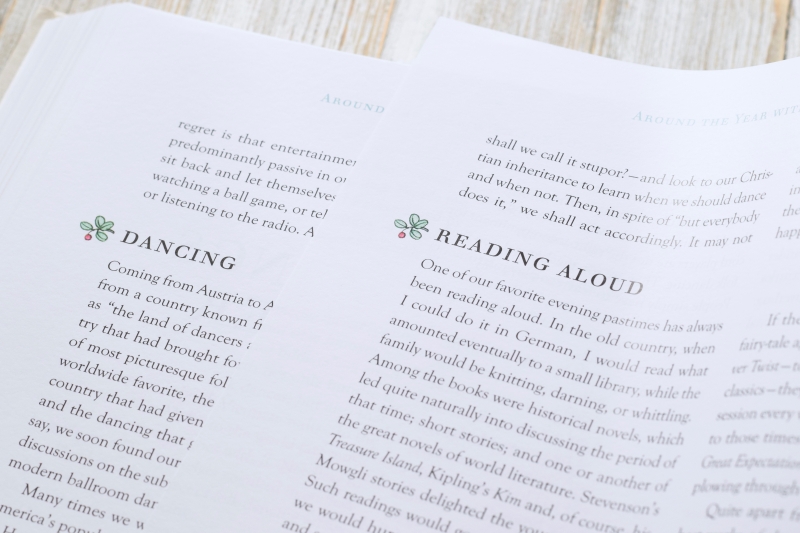
The last few chapters tackle some meaningful ways to grow family culture anchored to the Sacraments. Perhaps you may find some of the ideas “quaint” or “old fashioned” but I hope they will at least create a pause within (and perhaps even a conversation or two) to consider ways that family time is spent. Where we invest our time has important consequences. Perhaps there is a case to be made for the simpler cultural pursuits?
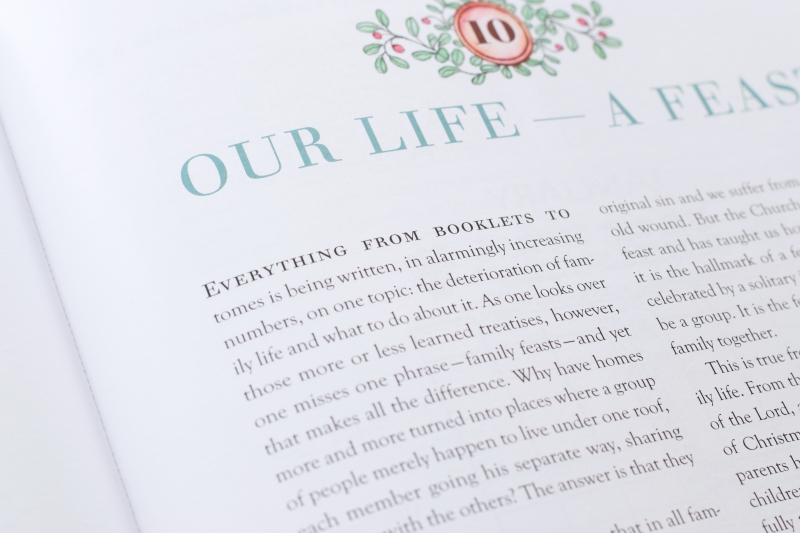
And beyond the richness of the liturgical year, the very last chapter encourages those examples and traditions that lend themselves to the unique expression of an individual family. The marking of days. They are simple ideas for weaving the family together through feasting, and by feasting, I mean celebrating. Celebrations happen within a group. In the liturgical year, we celebrate with the entire Body of Christ! In our family year, we celebrate with our family!
A word on the reprint and format:
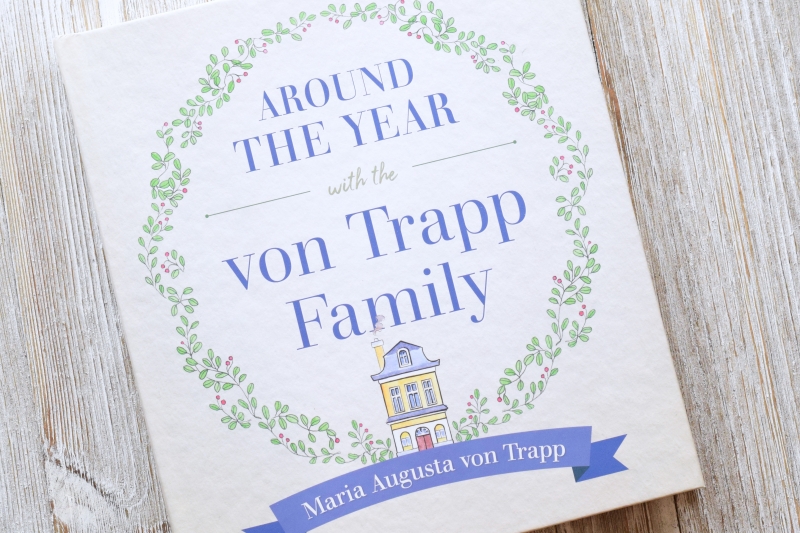
I care about old books! I treasure them! Much of my early mothering career was spent uncovering the fact that these old treasures existed at all, and then finding them to add to my home library. The internet was new, but this new and popular “live the liturgical year” phenomenon (which is good in so many ways) that we’re now experiencing hadn’t yet begun. There were just a handful of Catholic mothers looking to each other, gleaning information, and then hunting down books. So these treasured books are important to me; they’re old friends rescued (through my other good friend, ebay) from basements and cast aside boxes. And equally important to me is their faithful reproduction when they are reprinted, which is happening with so many of my old treasures. I’m overjoyed. It means my daughters will have these books at their finger tips. It means families will be richer for having access to them.
The reprint of Around The Year is a beautiful, hardbound cover. The size of the book is thinner but longer than the original. It’s a very good size for the shelf, but not too big to hold in your hands or on your lap. The paper is of excellent quality (Hi, I’m Jen, and I’m a paper nerd.). The paper has a very smooth feel, is substantial, and has a slight sheen to it (see image below). To me this allows the print and also the meticulously reproduced original illustrations (all by Rosemarie von Trapp) to really come to life. The music notations are clear, the images are crisp, in spite of being reproduced from a book now 64 years old.
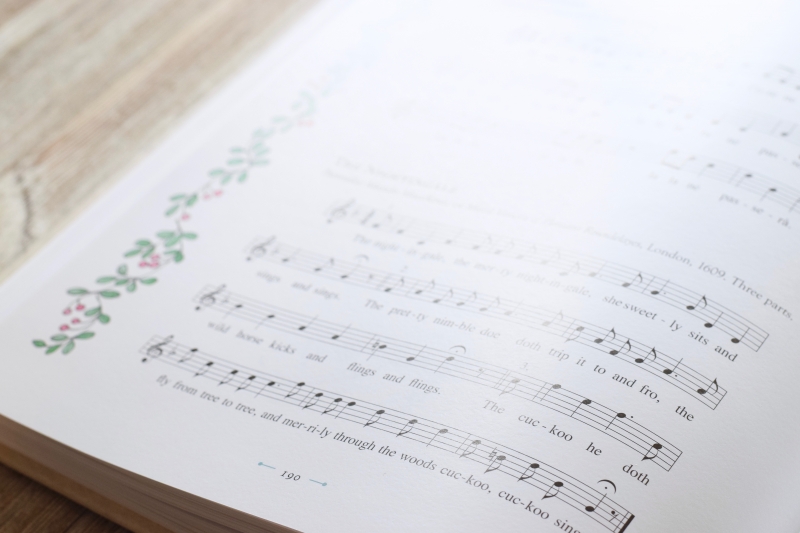
The illustrations:
There are many original illustrations in the original book, all completed by Rosemarie Trapp, the first daughter of Georg and Maria. (The other six older children were children of Georg and his first wife, Agathe; Georg and Maria went on to have three children together after their marriage.) These illustrations are among some of my favorite things in the book. They are sweet and endearing, and they inspired the illustrator in each of my children. All of the illustrations from the original book seem to have made their way into the newly reprinted edition, save a small handful.
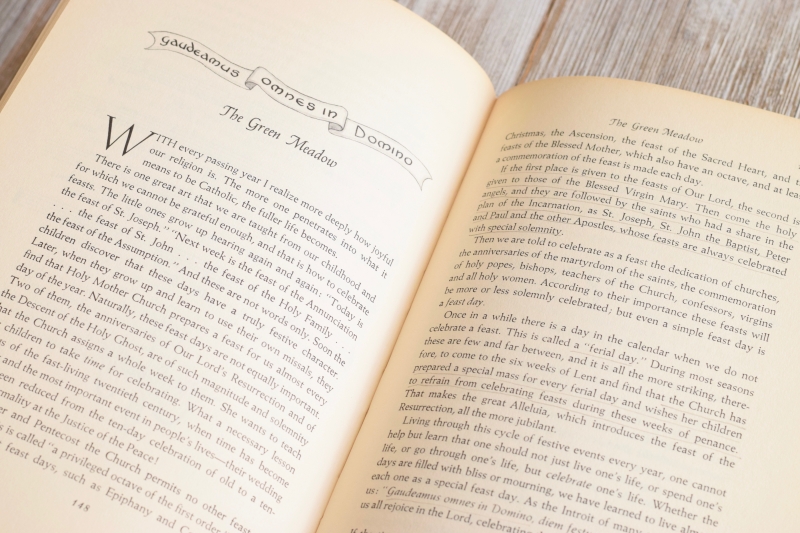
Across the top of each chapter (and a couple of sections, like Pre-Lent), Rosemarie has illustrated a simple banner that evokes the theme of the chapter and season. Either a verse or hymn or an image. There are 11 of them total in the original book. You can see an example above in the small banner present over the chapter title, The Green Meadow.
None of them are reproduced as the chapter heading – all chapter headings look like this:
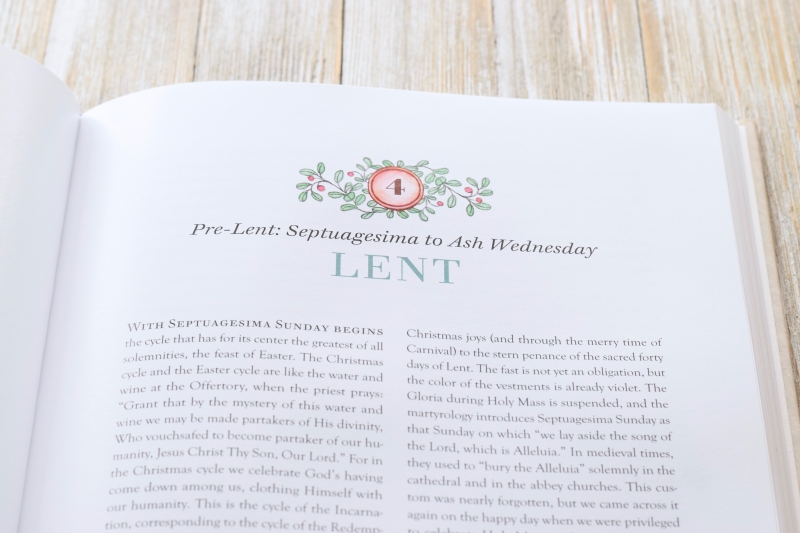
However, a few of the more beautiful chapter heading illustrations found their way inside the chapters, for example, I found the Advent header on page 32 within the Advent chapter of Sophia’s newly reprinted edition.
This was the ONLY departure I could find from the original, and it is minimal. The takeaway for me was the quality of the text, paper, and illustrations which I find to be beautiful and a lovely high quality – and the fact that it is a hardbound book! Be still my heart!

Perhaps, dear reader, you are a young mother just beginning to discover the liturgical year, yet you are overwhelmed with the voluminous amount of information poring in from every corner of the web? Perhaps, you are a grandmother, looking to put beautiful tools in the hands of your adult children to enrich their family? (This beautiful copy is going to straight into my married daughter’s hands upon completion of this review!) Perhaps you want a resource that nurtures ideas within the family, rather than an idea geared toward just your elementary age children? Maybe you’re looking for recipes, liturgical history, long-standing cultural traditions, music? It’s all here. This book is for everyone. For all of us. Because Feasts are for all.
May the ideas for celebrating along with the Church year that Sophia Institute Press has beautifully reprinted for us in Maria von Trapp’s Around The Year, find a place on your shelves, and its way into your home, which will be the richer for it. And may those ideas begin to weave in and out of every part of your day until living the liturgical year is simply an expression of the ordinary rhythm of your family’s days.






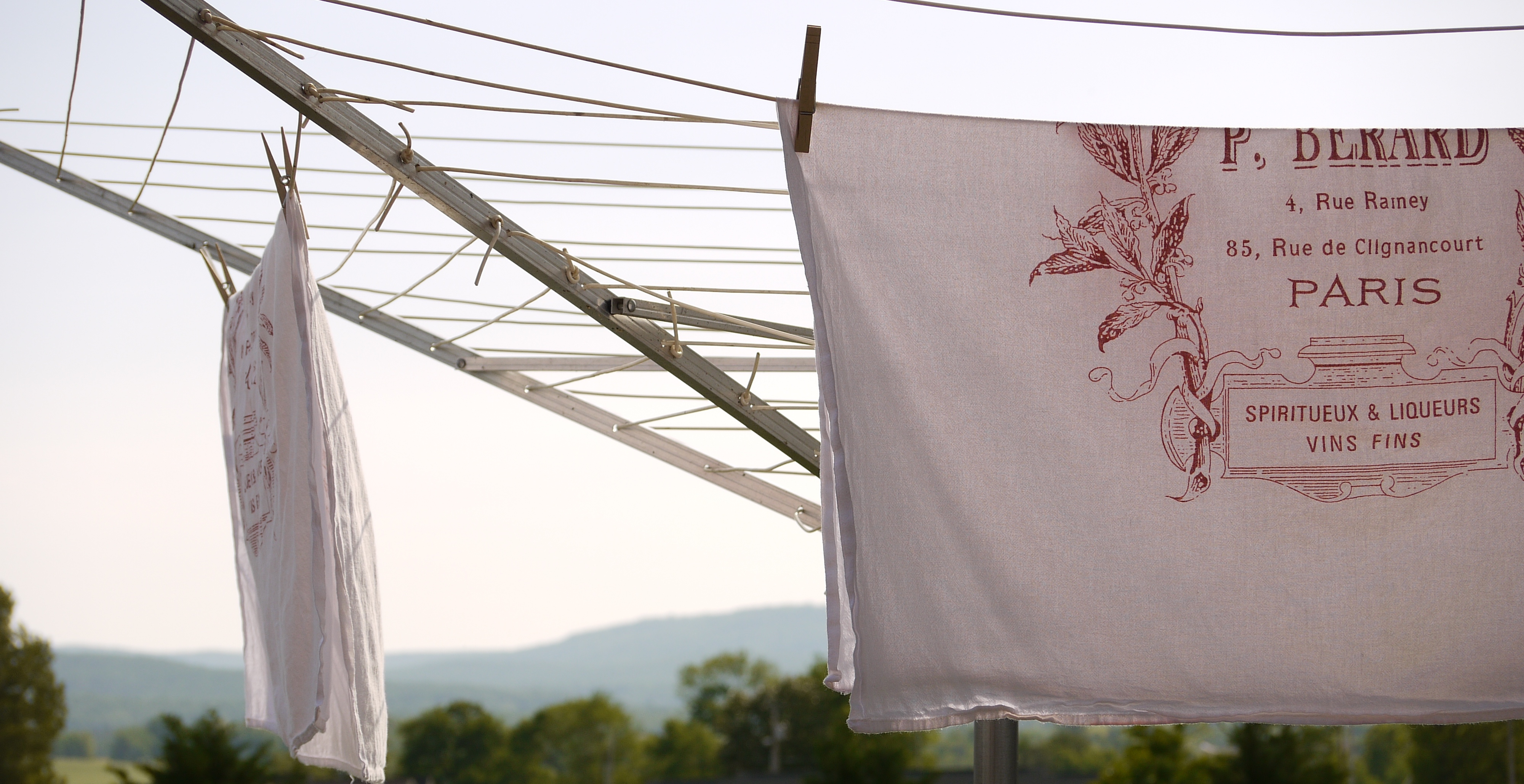
Oh wow, what a beautiful looking reprint! My goodness! Rarely does a reprint do the original justice, but this one seems to have only enhanced the loveliness.
Thank you so, so much for the peek inside! I have an original, but might purchase one of these to use as my workhorse (around sticky fingers 😉
I am so glad to know that someone else has memorized The Sound of Music – I always joke with my husband that if my life depended on it, I think I could re-write the entire script! 😉
Thanks again for the lovely review! So happy to see more blog posts!
Thank you for validating my love of all things Sound of Music!!! And yes, I admit I’ve been contemplating having this lovely reprint around here as an extra copy!! I just love the feel of the pages!
Thanks for your kind words, Meg!
Thank you so much for sharing this book and review. I’m eager to add it to our home library and even more excited to share it with my family.
I hope you’ll love the book as much as I have!
I’ve been wanting to get this book….it’s so lovely. Unfortunately, I can’t get your links to work but then again, my laptop is acting strangely today so perhaps the fault is from my end.
Hi Karyn,
For some reason, the links in the post when it was emailed didn’t work, but all the links work directly from my post. Try linking from the post directly. I know you’ll love having this beautiful book in your hands!
I have to tell you, I ordered this book as a result of your review. I’d read about it on Like Mother, Like Daughter but hadn’t committed (before the holiday’s) but your review drove it home. I’m trying to figure out a lot of things as a mom of 3 (4th on the way) under 9 and a new catholic (I also grew up with some of the VonTrapp family in central VT – who I had no idea came from Catholic roots) in a rural area with very little Catholic community to speak of (mostly elderly whose children have left the church). Not a lot of resources so I’m very much looking forward to this!
I’m thrilled you ordered and overjoyed for you to have this book in your hands! And I’ve been where you are: new Catholic trying to wrap your heart and head around all of this. As with all good and beautiful books and resources like this, it’s important to soak them up for a time. Let it live in the corners of your imagination and percolate. Return to it. And each season bring in one beautiful, new thing. Today is my 26th wedding anniversary so I’m the frame of mind to look back. It’s the small things, added joyfully, lived faithfully, and returned to year after year that build a family culture. Sending prayers, Mrs. Jackson, that this book is a tool for building that family culture in your home!
As a recently married man I was recommended this book several times over the past Advent and this Christmas season. Since I consider it primarily my responsibility to pass on the Faith to our future children I took great interest in the book. Thanks for your review!